Solution Manualfor Fluid Mechanics 2nd Edition by Hibbeler ISBN 013464929X9780134649290
Full link download Solution Manual: https://testbankpack.com/p/solution-manual-for-fluid-mechanics-2nd-edition-by-hibbeler-isbn-013464929x9780134649290/
1-1. Represent each of the following quantities with combinations of units in the correct SI form, using an appropriate prefix: (a) mm MN, (b) Mg/mm, (c) km/ms, (d) kN/(mm)
a)
b)
c)
d)
a) kN·m
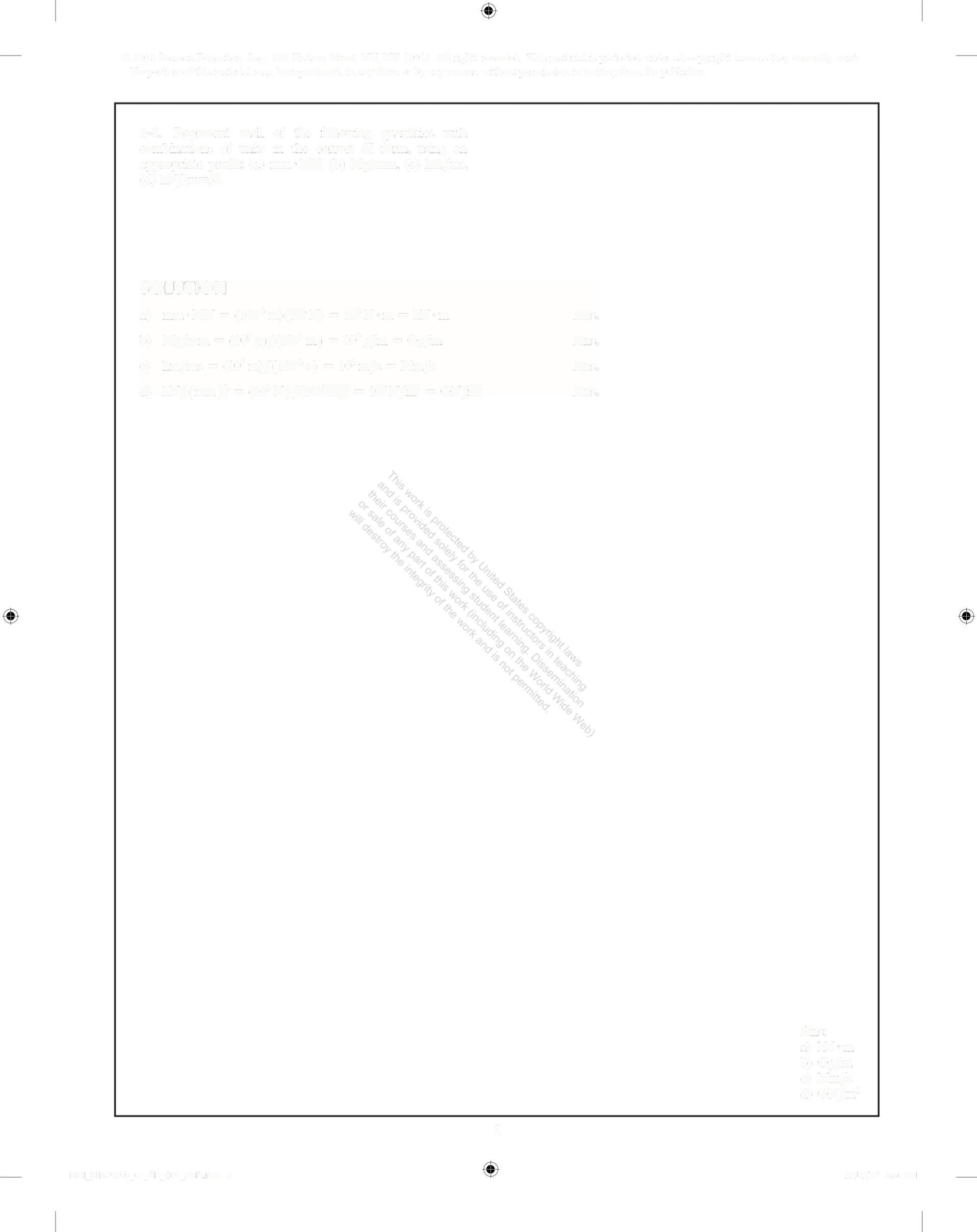
b) Gg/m
c) Mm/s
d) GN/m?
1-2. Evaluate each of the following to three significant figures, and express each answer in SI units using an appropriate prefix: (a) [486(10)] mm, (b) (348 mm), (e) (83700mN
a) 23 6 Gm
b) 42 1(10) m'
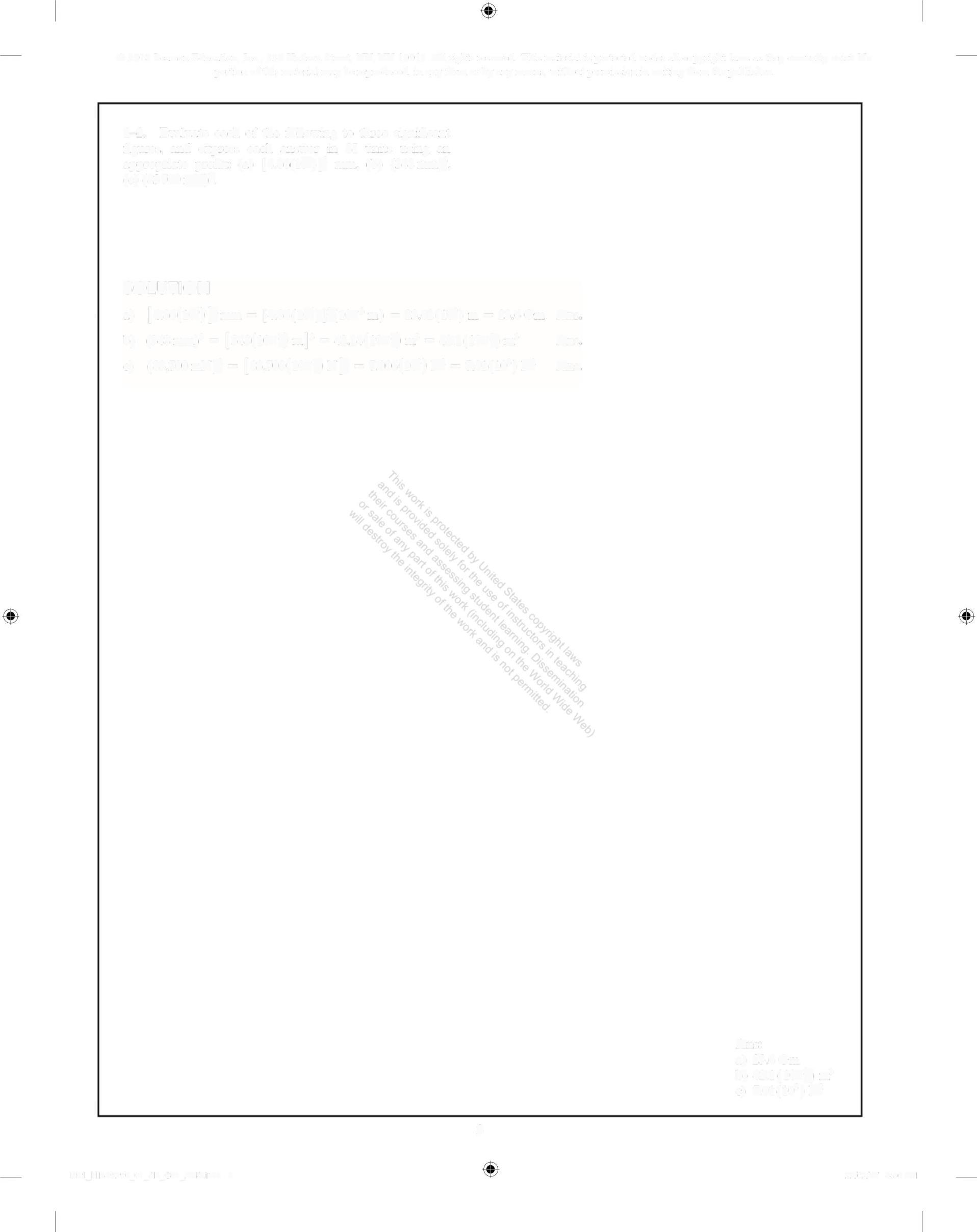
1-3. Evaluate each of thefollowing tothreesignificant figures, and express each answer in ST units using an appropriate prefix: (a) 749 µ,m/63 ms, (b) (34 mm)(0 0763 Ms)/263 mg, (c) (4 78 mm)(263 Mg)
SOLUTION
a) 749m/63 ms = 749(10) m/63(10)s = 1188(10) m/s
= 11 9 mm/s Ans
b) (34 mm)(0 0763 Ms)/263 mg= [34(10) m][0 0763(10)s]/[263(10)(10') g]
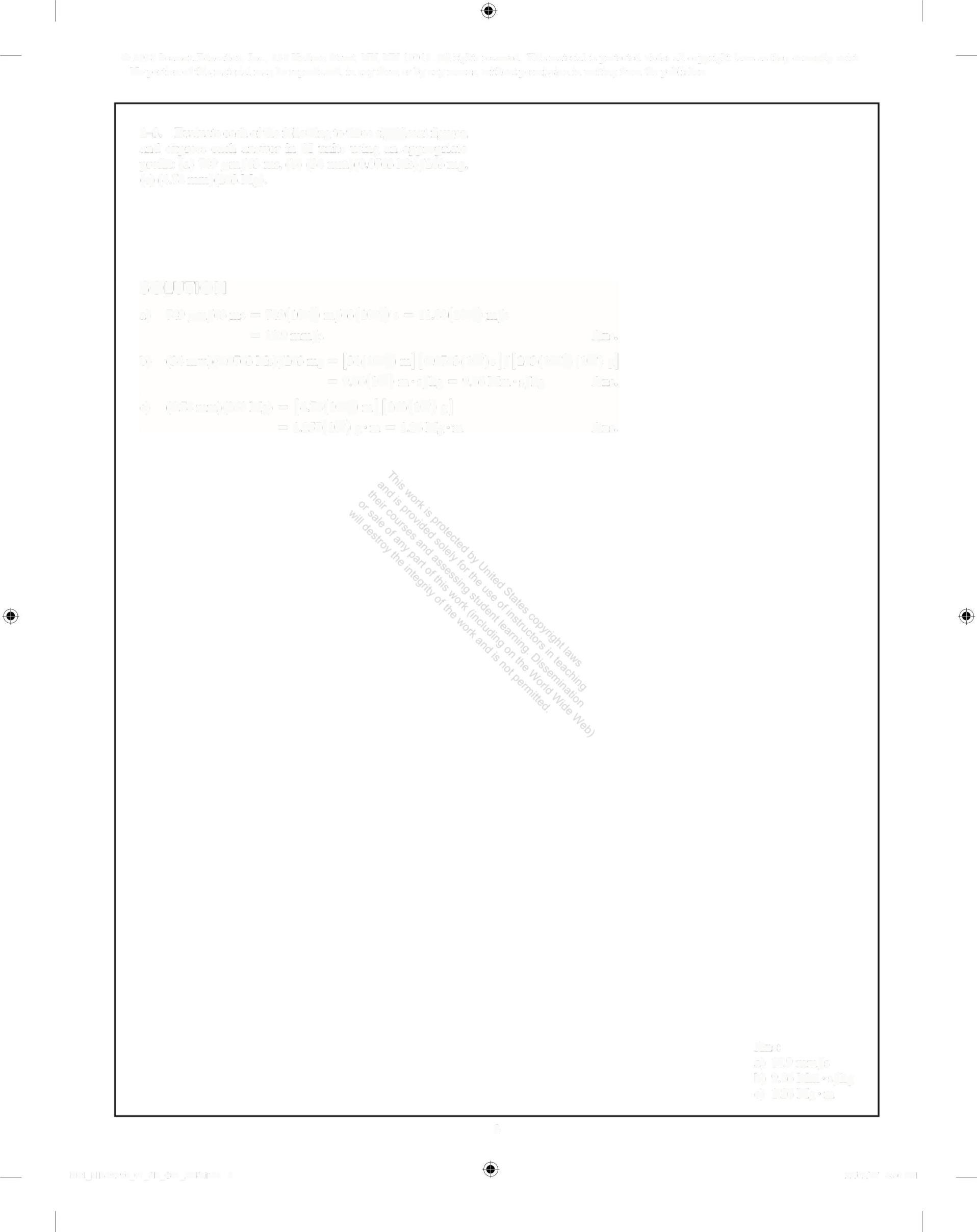
= 986(10) m s/kg = 986 Mm s/kg Ans
e) (4.78 mm)(263Mg) = [4.78(10)m][263(10) g]
= 1257(10)g·m = 126Mg·m Ans.
Ans:
a) 119 mm/s
b) 9 86 Mm s/kg
c) 126 Mg· m
1-4. Convert the following temperatures: (a) 250 K to degrees Celsius, (b) 322F to degrees Rankine, (c) 230°F to degrees Celsius, (d) 40C to degrees Fahrenheit.
SOLUTION
a) T= Te + 273; 250K = T + 273 T= 230C
b) T,=T, + 460 = 322F + 460 = 782R
e) T=, -32) -}or -3s2) = 1orc
) T%=;(r, -s2) 4rc=(r,-32) T, = 1+F
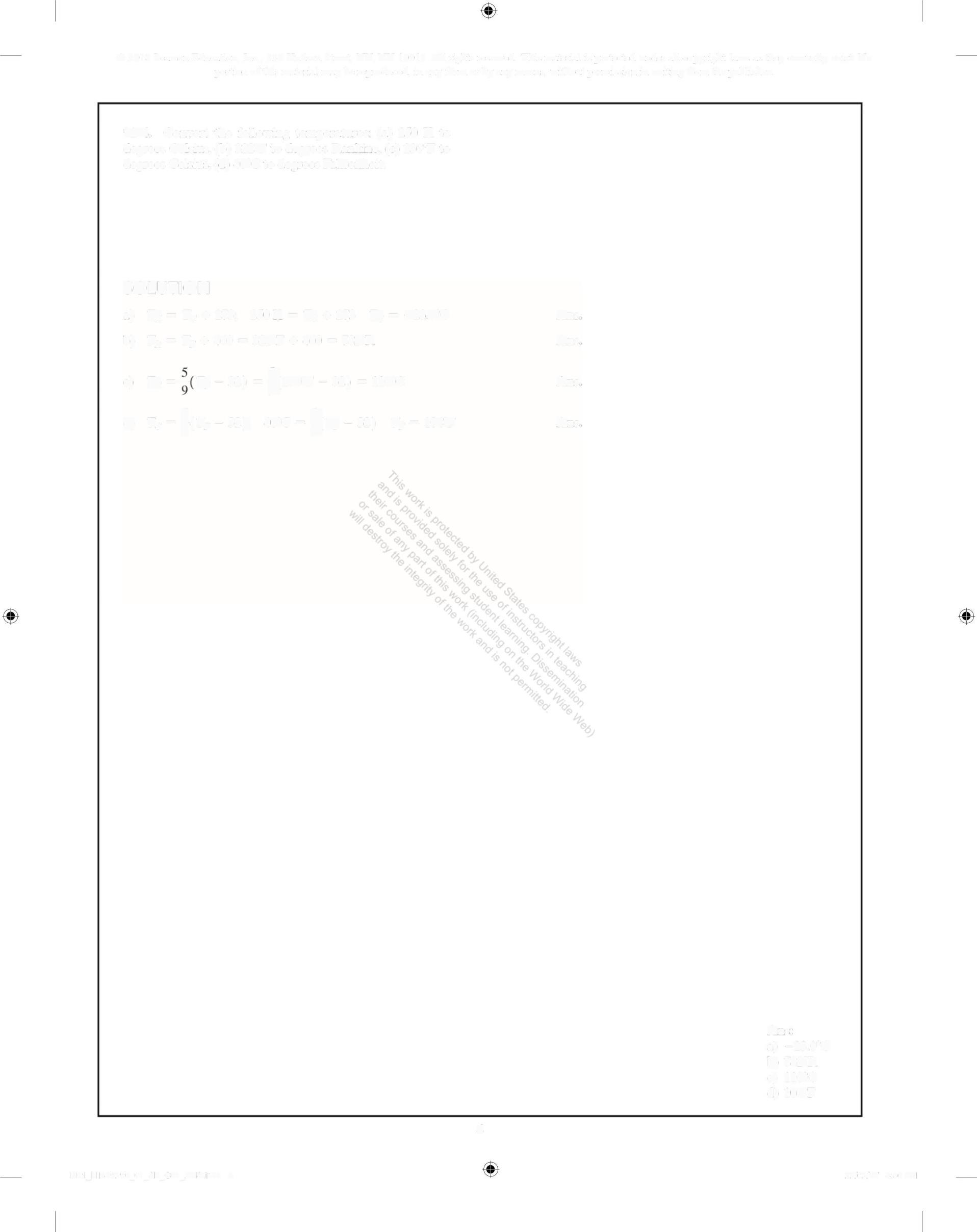
Ans. Ans. Ans. Ans
Ans:
a) -23 0°C
) 782R
e) 110C
d) 104F
> 1-5. The tank contains a liquid having a densityof 1.22 slug ft Determine the weight ofthe liquid when it is at the level shown
SOLUTION
The specific weight ofhe liquid and the volume ofth liquid are
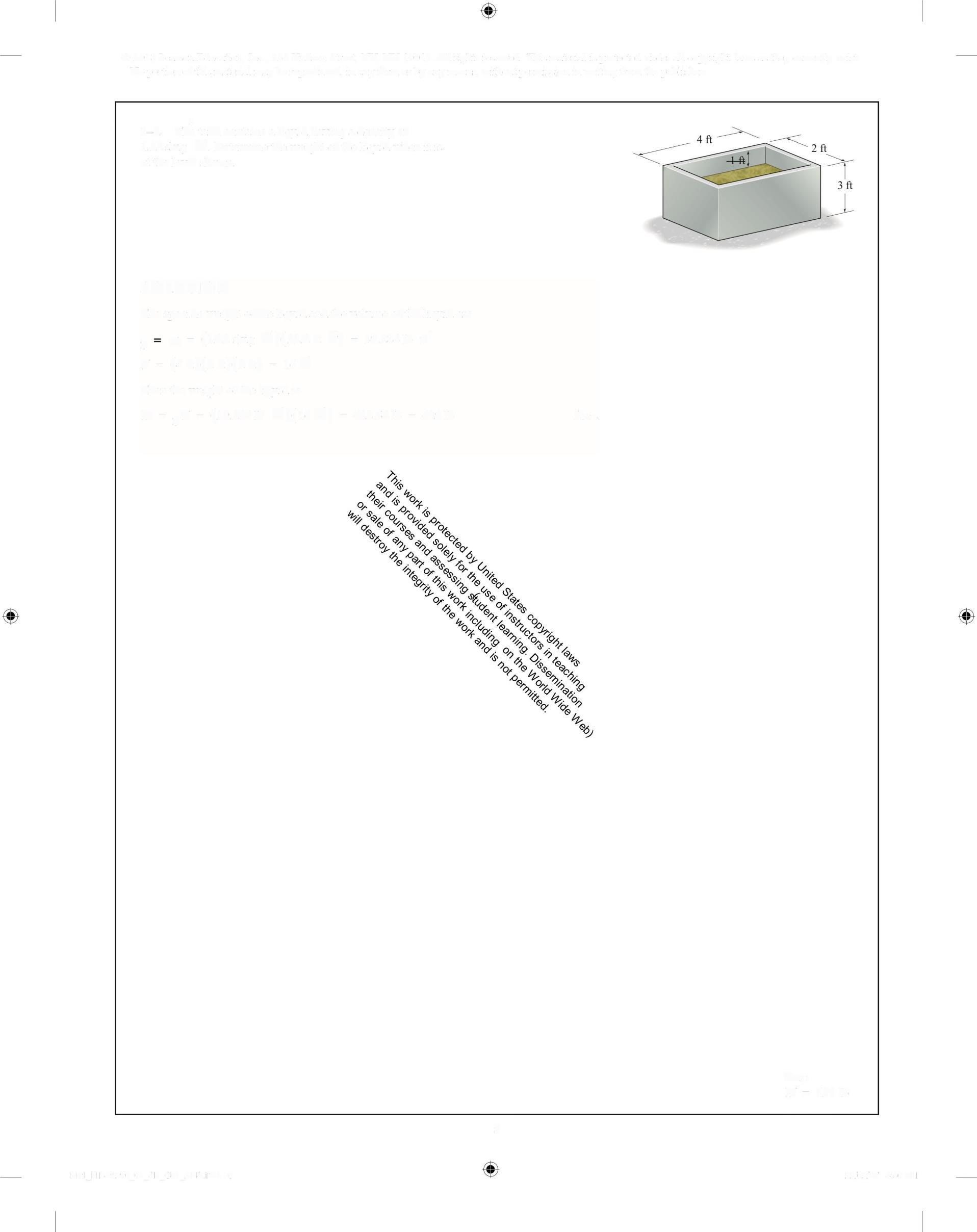
gr&=(122slug ft)(32.2n s) = 39 284 1b f'
4 = (4f)(2f)(2f) = 16f
Then the weight ofthe liuid is
W=gl =(39 284lb ft)(16f) = 628.54 lb = 629 1b Ans.
Ans: W= 62916
1-6. Ifair within the tank is at an absolute pressure of 680 kPa and a temperature of 70°C, determine the weight of the air insidethe tank The tank has an interior volume of 1.35 m'
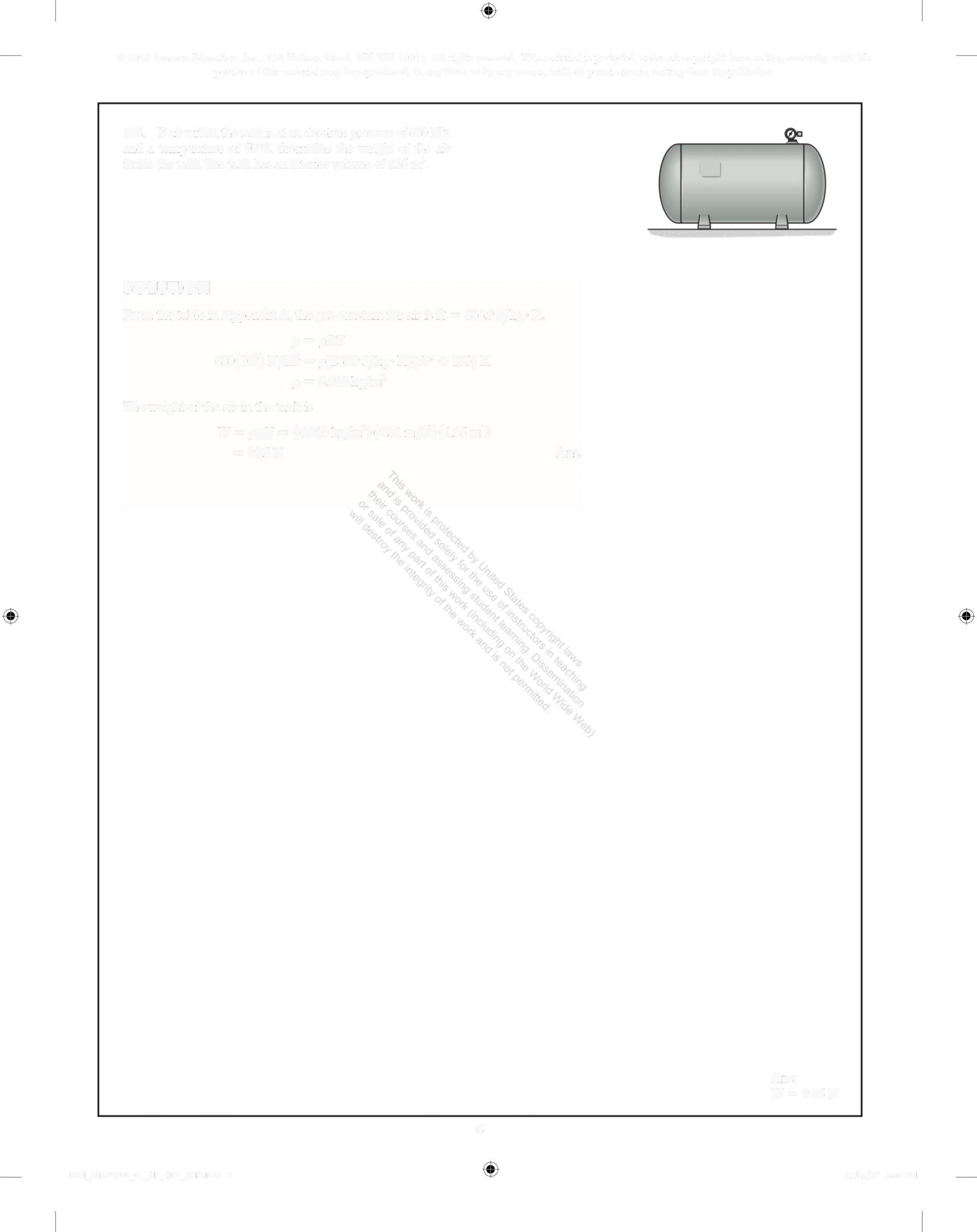
SOLUTION
From the table in Appendix A, the gas constant for air is R = 286 9 /kg K
p=oRT
680(10') N/m = p(286 9 J/kg K)(70° + 273)K
p = 6 910 kg/m3
The weight of the air in the tank is
W=og= (6910kg/m')(9 81 m/s)(1 35 m')
= 91 5 N
Ans.
Ans: W = 91.5 N
1-7. The bottle tank has a volume of0.35 m' and contains 40 kg ofnitrogen at a temperature of 40°C Determine the absolute pressure in the tank
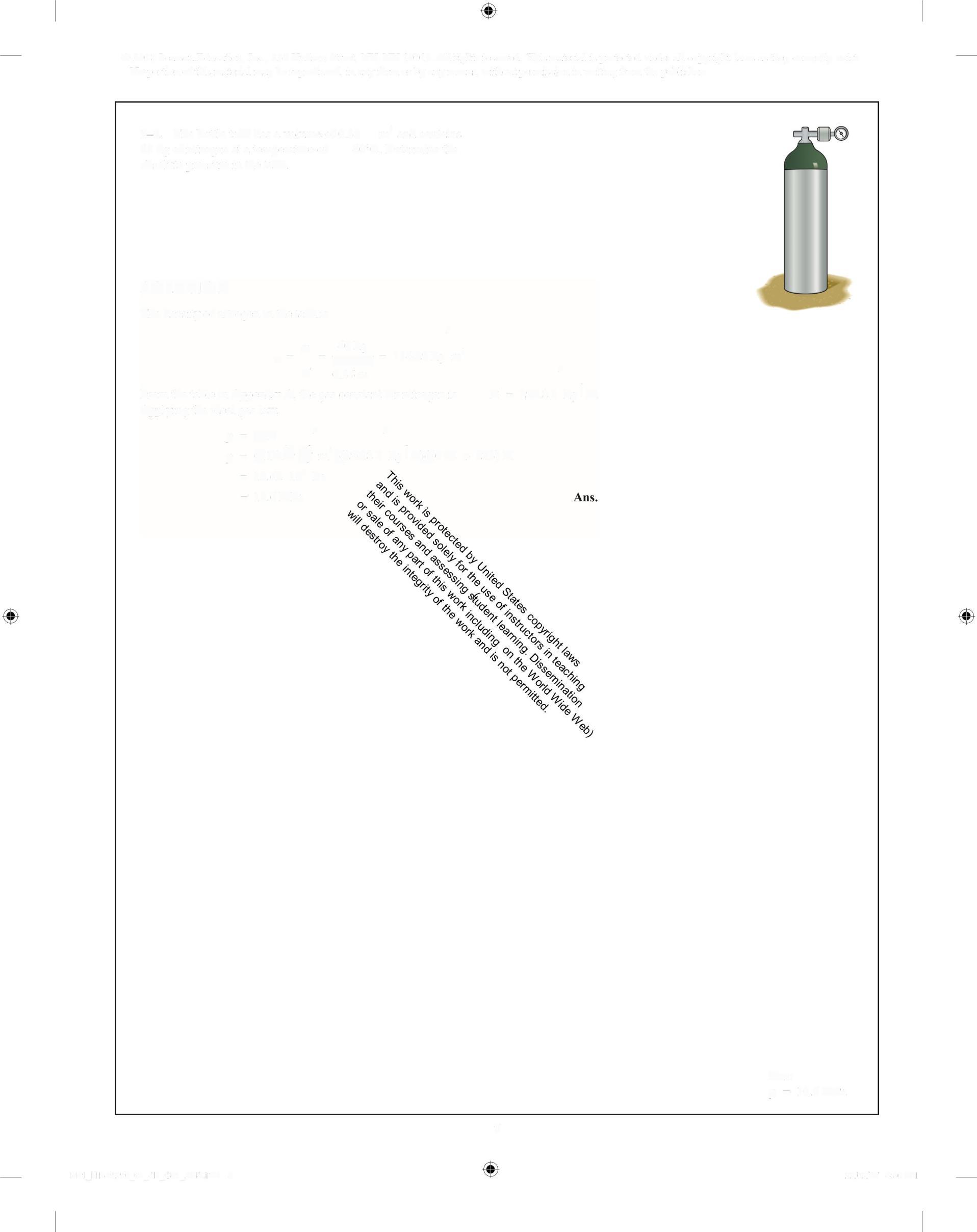
SOLUTION
The density ofnitrogen in the tank is
m = , 40kg = 11429kg m
4 0.35 m
From the table in Appendix A, the gas constant for nitrogen is Applying the ideal gas law,
p= RT > >
p = (1491 m')0296 8 J kg'K)40€ + 273)K = 10 62 10° Pa = 10.6MPa
1-8. The bottle tank contains nitrogen having a temperature of 60°C. Plot the variation of the pressure in the tank (vertical axis) versus the density for 0 = p = 5kg/m' Report values in increments of Ap = 50 kPa
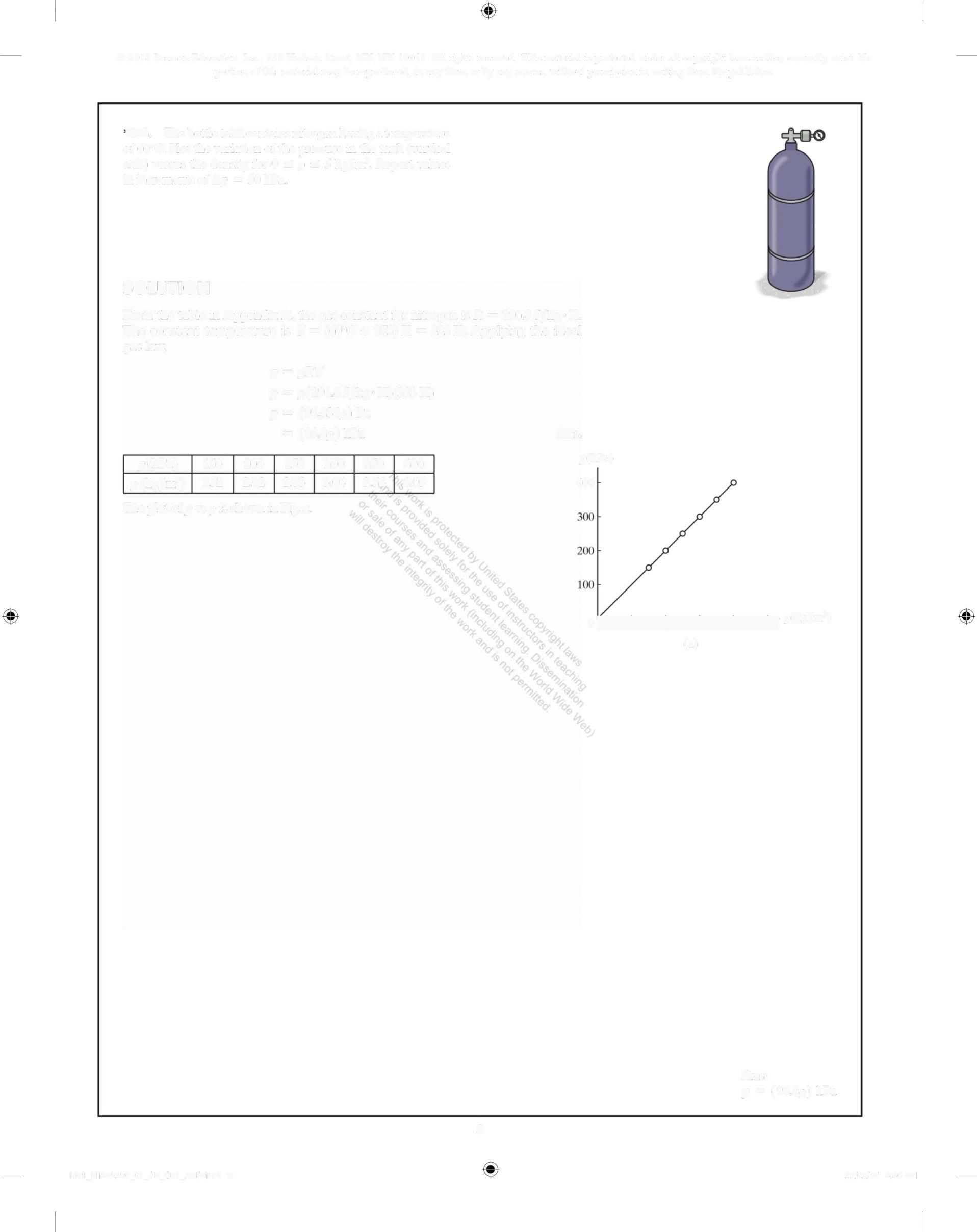
SOLUTION
From the table in Appendix A, the gas constant for nitrogen is R = 296 8 J/kg K The constant temperature is T = (60°C + 273) K = 333 K. Applying the ideal gas law
p = pRT
p = p(296 8 J/kg K)(333 K)
p = (98.,834p) Pa =(98 8p) kPa
p(kPa) 150 200 250 300 350 400
52 202 2 53 3 04 3 54 4 05
p
The plot of p vs p is shown in Fig a
Ans: p =(98 8p) kPa
1-9 Determine the specific weight ofhydrogen when the temperature is 85 °C and the absolute pressure is 4 MPa
SOLUTION
From the table in Appendix A, the gas constant for hydrogen is Applying the ideal gas law,
?p=RT >
R =4124J kg'K
m' = 44124J kg'K)(85C + 273)K = 2 7093kg m
Then the specific weight ofhydrogen is > >
g =rg=(7093kg m)(9 81m s) = 26 58 m' = 26.6N m'

Ans.
> Ans:
g =26 6N m'
1-10. Dry air at 25 °Chas a density of 1.23 kg m 3 But ifit has 100% humidity at the same pressure, its density is 0.65% less At what temperature would dryair produce this same smaller density?
SOLUTION > > >
For both cases, the pressures are the same Applying the ideal gas la w with r = 1.23kg m', r = (1.23kg m)(1 -0 0065) = 1222005kg m' and T =05c + 273) = 298K > I
P = +RT,= (1.23kg m')R (298 K) = 366.54 R
Then >
366 54R = (1 222005kg m')R(T + 273)
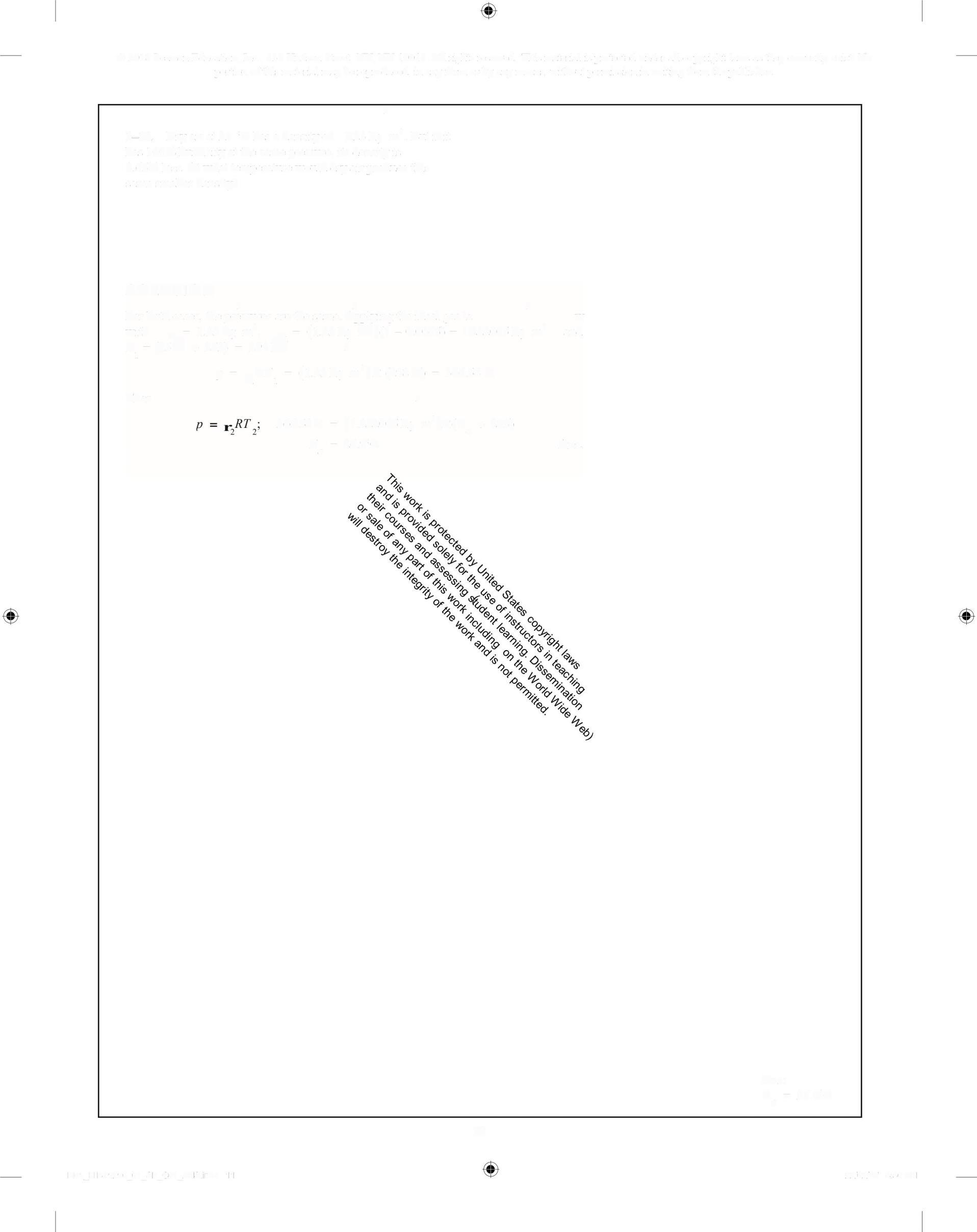
T = 26 9°C
Ans.
Ans:
T = 26 9C
1-11. The tanker carries 900(10) barrels ofcrude oil in its hold.
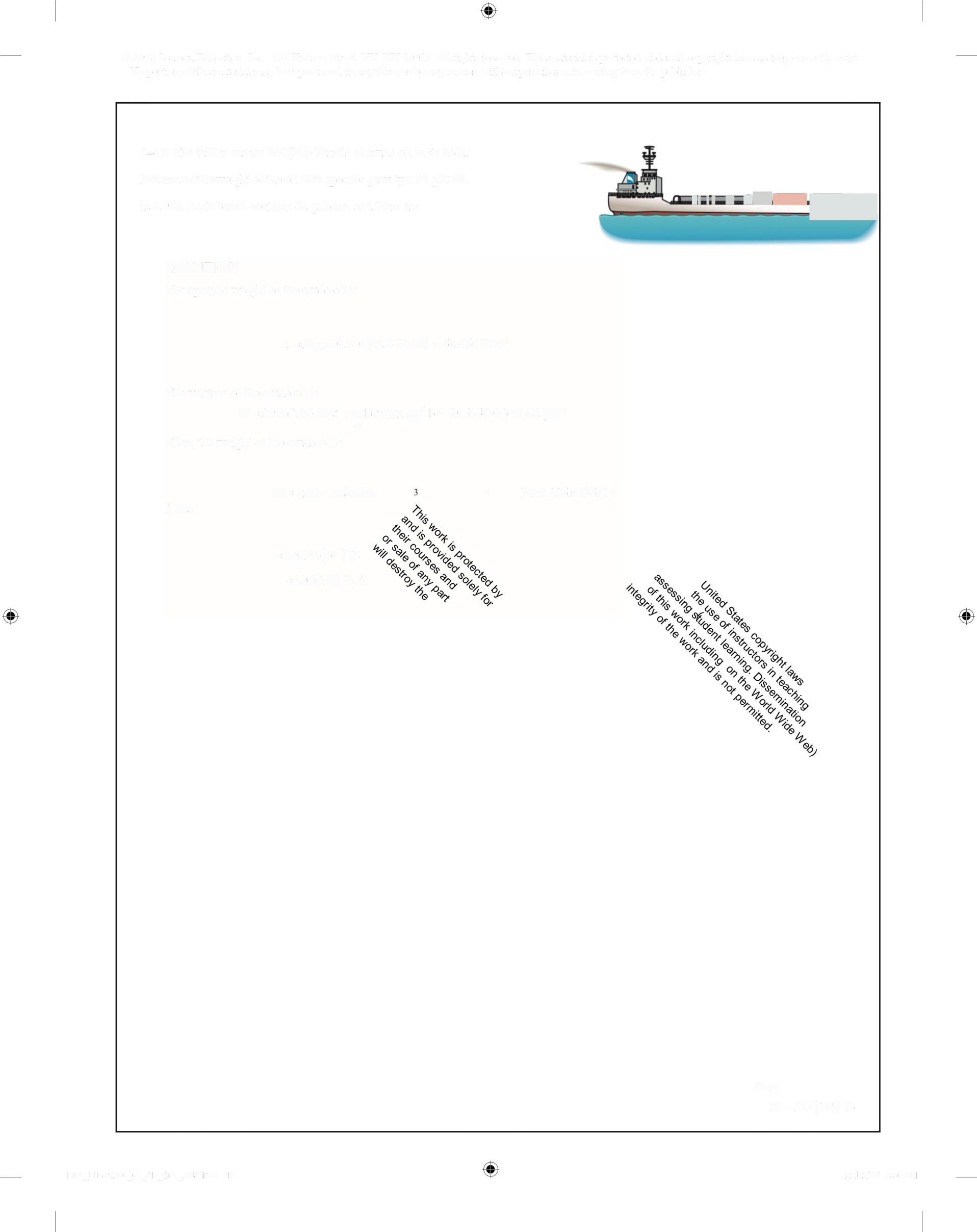
Determine the weight ofthe oil ifits specific gravity 748 gal>ft is 0940 Each barrel contains 42 gallons, and there are lit ti
SOLUTION
The specific weight ofthe crude oil is
g»=Sg=0 940(62 4 lb>ft) = 58.656 lb>ft'
The volume ofthe crude oil is , = 3900(10) bl4a 1 1b a748 gal'b = 5 0535(106) ft 42 gall ft
Then, the weight ofthe crude oil is
W=g4= 158 656% 6 lb>ft 235 0535110
2 f4
= 296 41(10 ) 1b
= 296(10) 1b A
Ans: W = 296(10) 1b

1-12 Water in the swimming pool has a measured depth of 3 03 m when the temperature is 5°C. Determine its approximate depth when the temperature becomes 35°C. Neglect losses due to evaporation
SOLUTION
From Appendix A, at T, = 5C, (p) = 1000 0 kg/m The volume of the water is = Ah Thus , = (9m)(4 m)(3 03 m) Then
AtT, = 35°C, (0,)» = 994 0kg/m Then

1-13. Determine the weight of carbon tetrachloride that should be mixed with 15 lb of glycerin so that the combined mixture has a density of 2 85 slug/ft3
SOLUTION
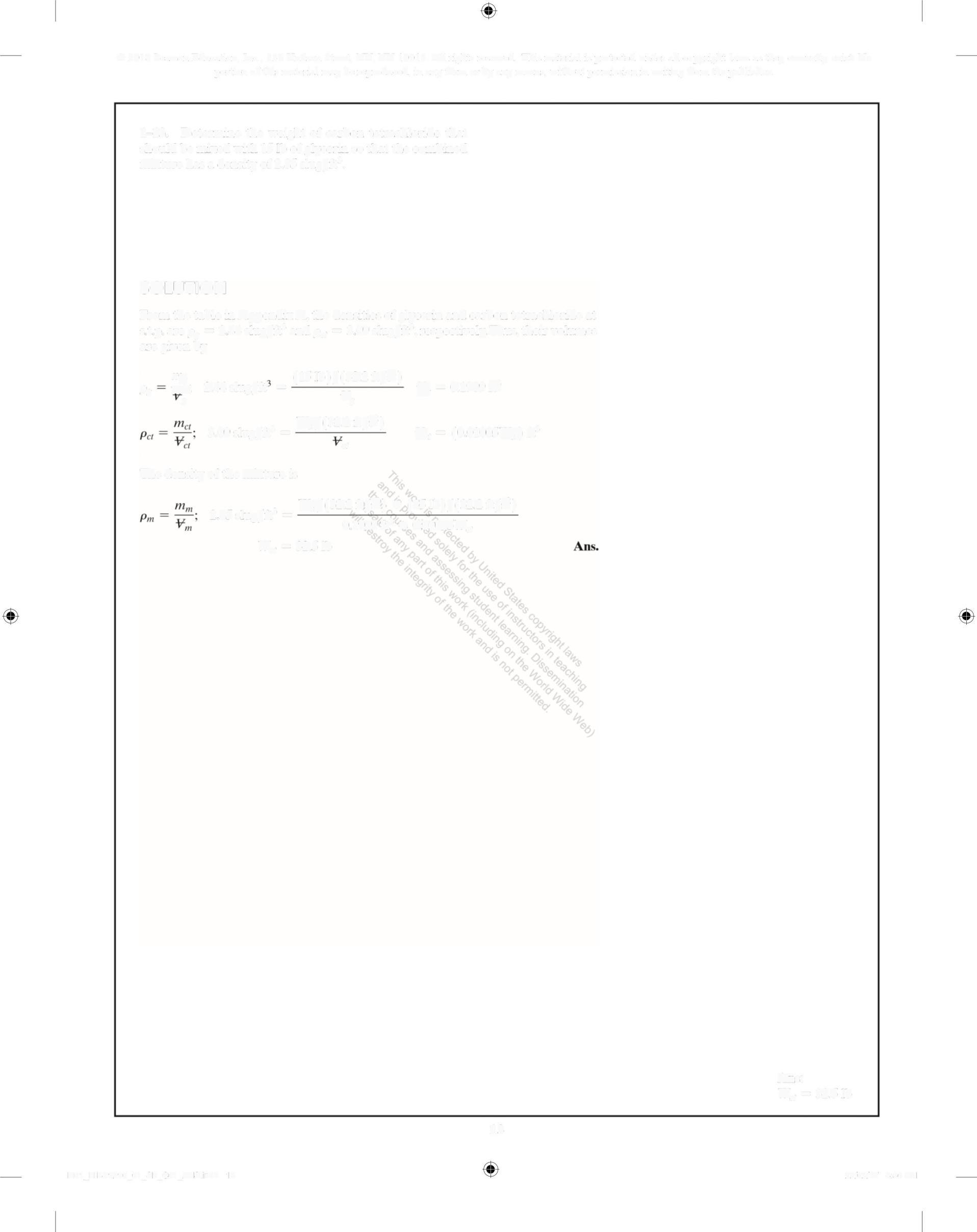
From the table in Appendix A, the densities of glycerin and carbon tetrachloride at st p are p, = 244 slug/ft' and pa = 3 09 slug/ft', respectively. Thus, their volumes are given by
The
1-14. The tank contains air at a temperature of 18C and an absolute pressure of 160 kPa If the volume of the tank is 3 48 m' and the temperature rises to 42°C, determine the mass of air that must be removed from the tank to maintain the same pressure

SOLUTION
For T,= (18°C + 273) K = 291 K and R = 286 9J/kg K for air (Appendix A) the ideal gas law gives 160(10') N/n = p,(286 9 J/kg K)(291 K)
p, = 19164 kg/m'
Thus, the mass of the air at T, is
m, =p =(1 9164 kg/m') (3 48 m') = 6 6692 kg
For T,= (42C + 273)K = 315K, and R = 2869J/kg·K, p=oRT; 160(10)N/nm = p5(286 9 J/kg K)(315 K)
p = 1 7704 kg/m'
Thus, the mass of air at Tis
m=p = (1 7704 kg/m) (3 48 m) = 6 1611 kg
Finally, the mass of air that must be removed is
Am = m, m, = 6.6692kg 6.1611 kg = 0.508kg Ans.
Ans: Am = 0 508 kg
1-15. The tank contains 4 kg of air at an absolute pressure of 350 kPa and a temperature of 18C If 0 8 kg of air is added to the tank and the temperature rises to 38°C, determine the resulting pressure in the tank
SOLUTION
For T, = (18C + 273)K = 291K p, = 350kPa and R = 286 9J/kg K for air (Appendix A), the ideal gas law gives
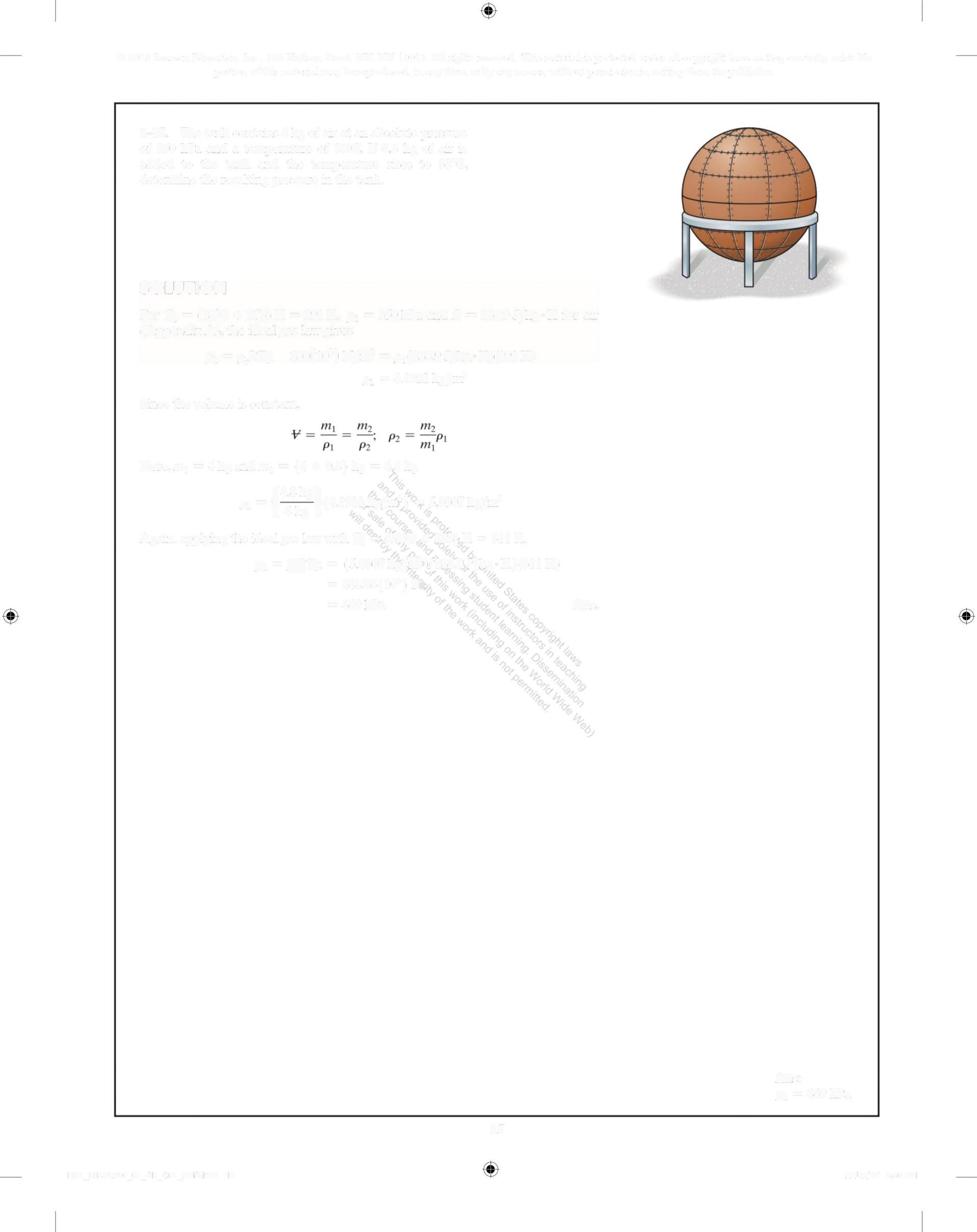
p, =o,RT 350(10') N/m = ,(286 9 J/kg K)(291 K)
p, = 4 1922kg/m'
Since the volume is constant,
Here,m, = 4kgandm, = (4 + 0 8)kg = 4 8kg
4 8 p2 = ( kg)(4 1922 kg/m3 ) = 5 0307 kg/m'
4 kg
Again, applying the ideal gas law with T, = (38C + 273)K = 311 K, p =RT; = (5 0307 kg/m)(286 9 J/kg K)(311 K) = 44886(10') Pa
= 449 kPa
Ans.
Ans: p = 449kPa
1-16. The 8-m-diameter spherical baUoon is filled with helium that is at a temperature of 28°C and an absolute pressure of 106 kPa Determine the weight of the helium contained in the balloon The volume of a sphere is V =
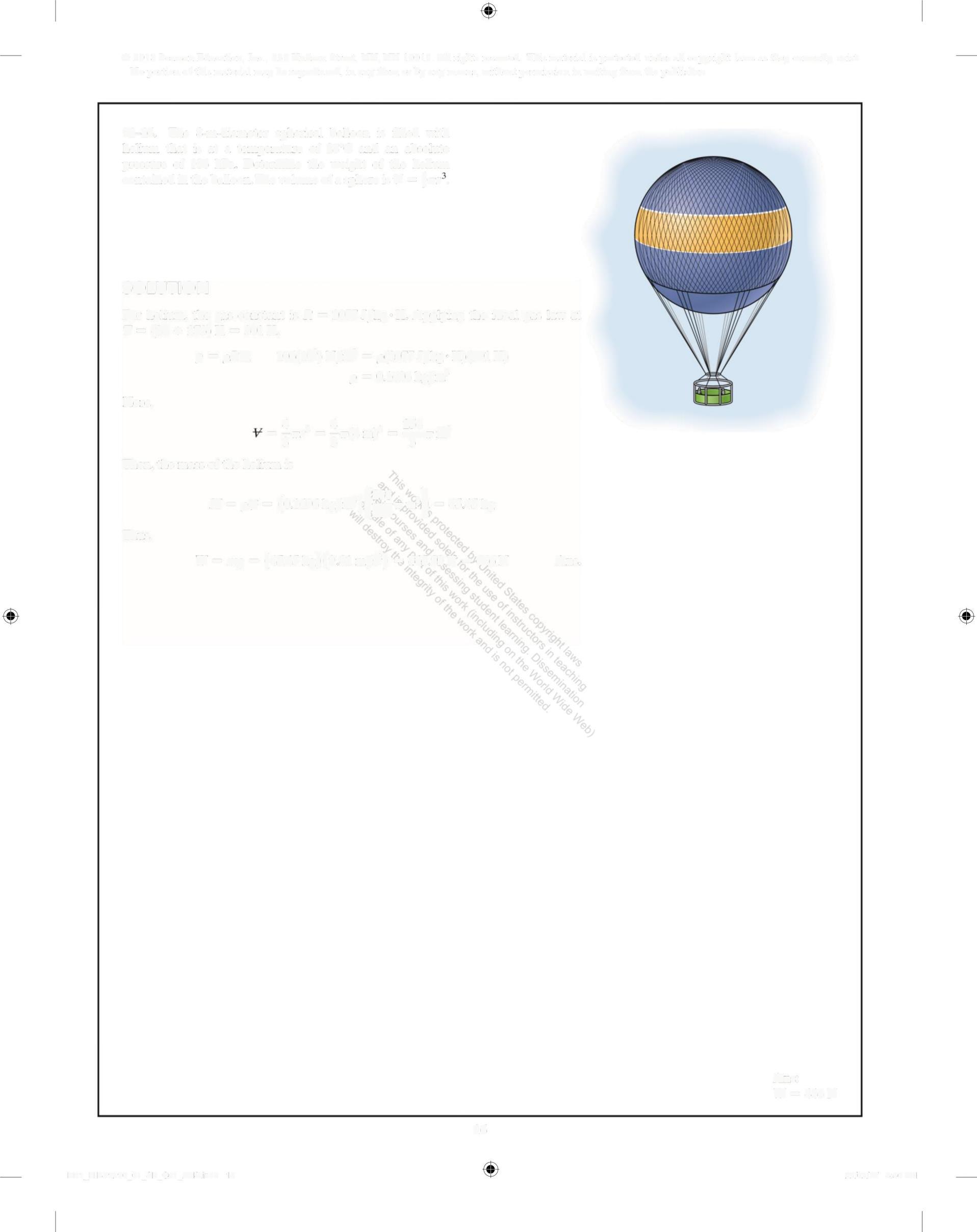
SOLUTION
For helium, the gas constant is R = 2077 J/kg K Applying the ideal gas law at T =(28 + 273) K = 301 K.
p= oRT 106(10)N/n = p(2077 J/kg K)(301 K) p = 0 1696kg/m'
Here,
Then,
Thus,
Ans: W = 446N
1-17. Gasoline is mixed with 8ft' of kerosene so that the volume of the mixture in the tank becomes 12 ft3 • Determine the specific weight and the specific gravity of the mixture at standard temperature and pressure
SOLUTION
From the table in Appendix A, the densities of gasoline and kerosene at stp are p = 1 41 slug/ft and p = 1 58 slug/ft,respectively. The volume of gasoline is
=12ft'8ft' = 4ft'
Then the total weight of the mixture is therefore
W, =Pg', + ugh
= (141 slug/rte)(322 ft/s)(4 f) + (158 slug/ft')(322 ft/s)(8 ft)
= 588 62 lb
Thus, the specific weight and specific gravity of the mixture are
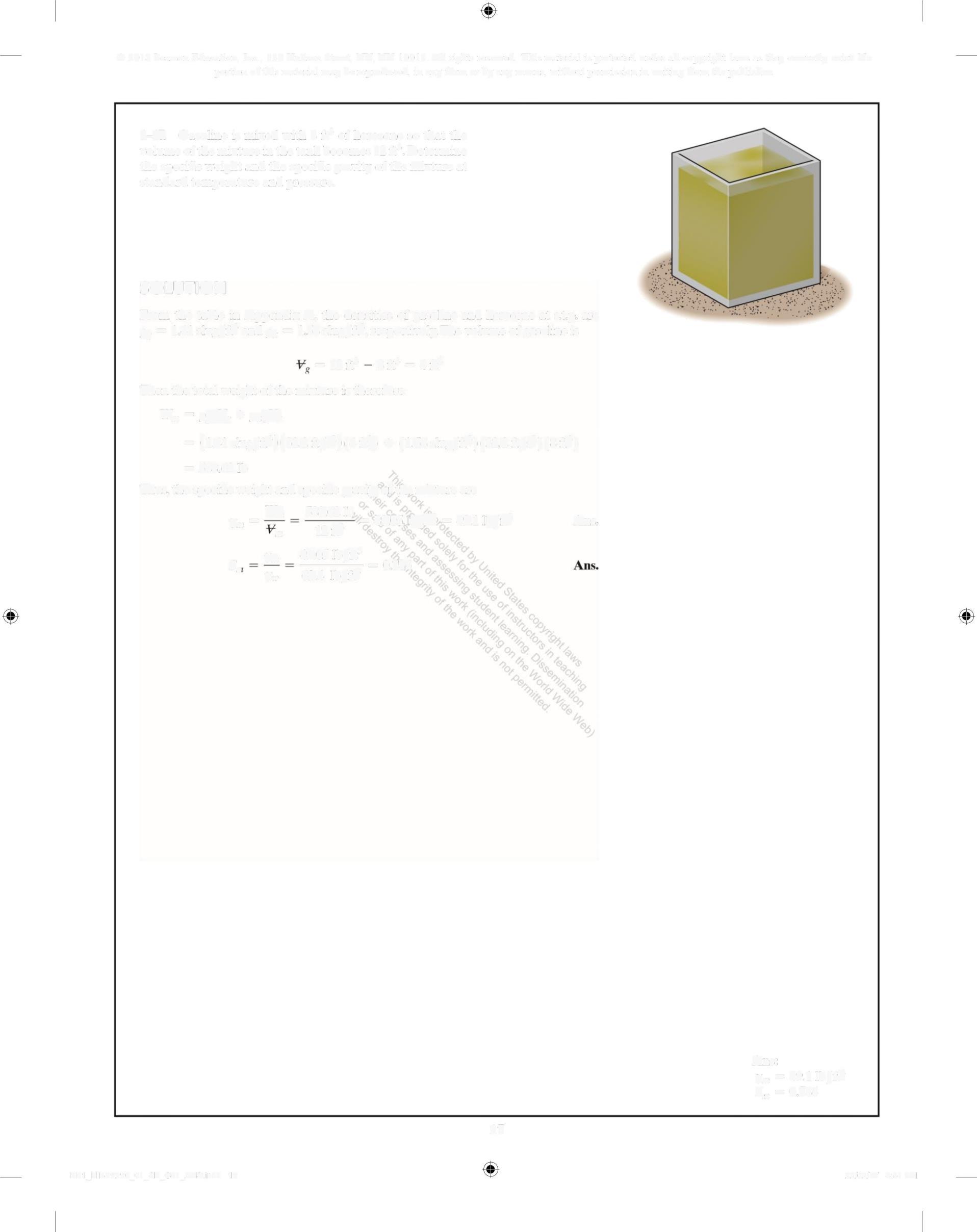
% 588 62lb 49 05 I/fe = 49 1 1/ft
Y% 12f Ans
s. n m Y% 49 05 1b/ft' - -= 0 786 62 4 Ib/ft
Ans:
Y%=49 1 lb/ft
S,,=0.786
1-18. Determine the change in the density of oxygen when the absolute pressure changes from 345 kPa to 286 kPa, while the temperature remains constant at 25°C. This is called an isothermal process
SOLUTION
Applying the ideal gas law with T, = (25C + 273)K = 298K, p, = 345 kPa and R = 259 8 J/kg K for oxygen (table in Appendix A),
p, =RT: 345(10')N/m = o,(259 8J/kg K)(298 K)
p = 4 4562 kg/m'
For p = 286kPa and T, = T, = 298 K, 286(10') N/m? = o,(259 8 J/kg K)(298 K)
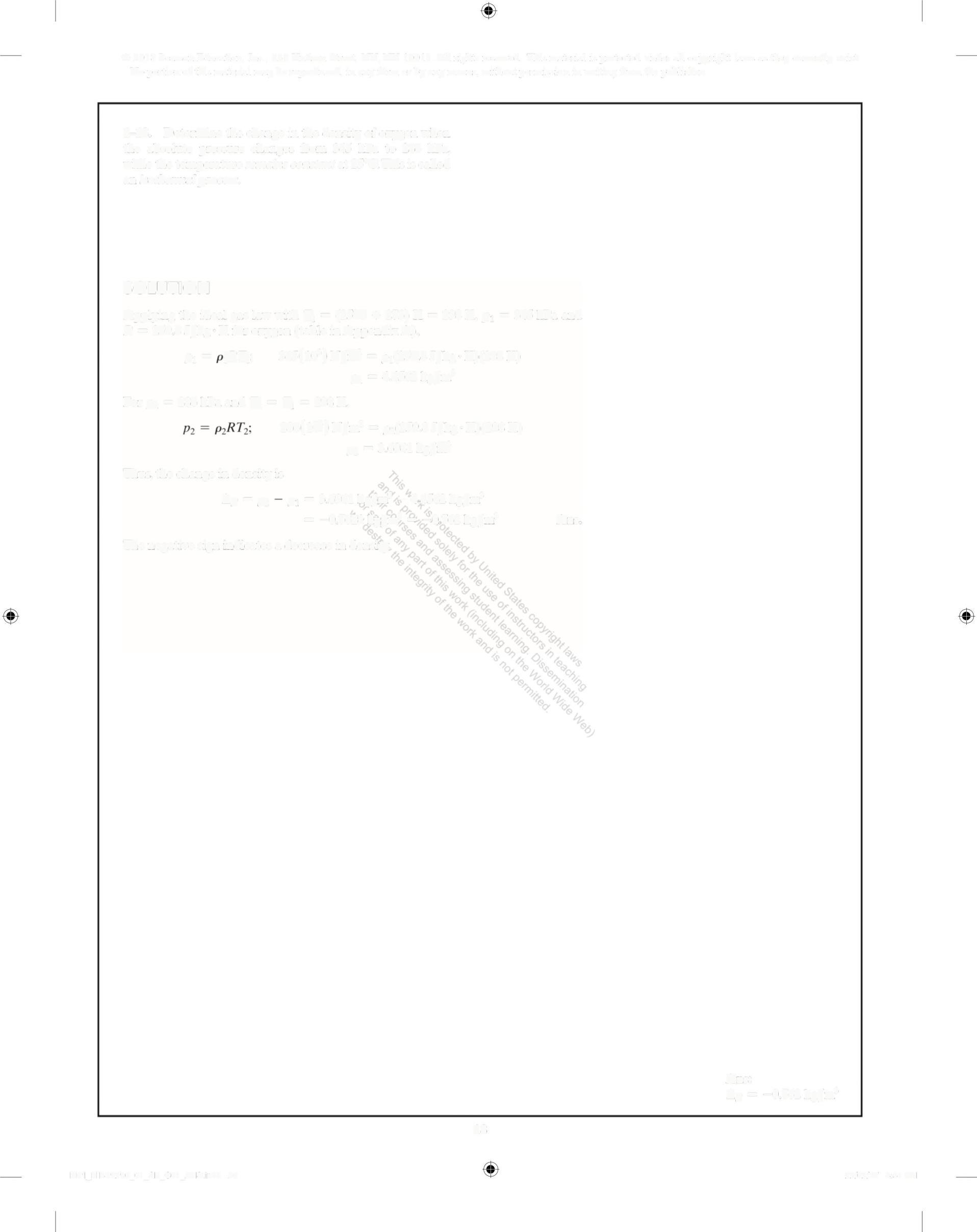
p = 3 6941 kg/m
Thus, the change in density is
Ap =p 0, = 3 6941 kg/m' -4 4562 kg/m' = -0 7621 kg/m' = -0 762 kg/m3 Ans
The negative sign indicates a decrease in density
Ans: 4p = -0 762 kg/m'
1-19 The container is filled with water at a temperature of25 °C and a depth of2 5 m If the container has a mass of 30 kg, determine the combined weight ofthe container and the water.
SOLUTION >
From Appendix A, r, = 997.1 kg m'at T = 25C Here, the volume ofwater is += wh=l05m(25m) = 0 625m'

Thus, the mass ofwater is >
M_ = =997.1kg m'(0.625,m) = 1957.80kg
The total mass is
w MW
M = M + M = (1957.80 + 30) kg = 1987 80 kg
T w €
Then the total weight is
W=M,g=
Ans: W= 19 5kN
1-20 The rain cloud has an approximate volume of 6 50 mile' and an average height, top to bottom, of 350 ft. If a cylindrical container 6 ft in diameter collects 2 in of water after the rain falls out of the cloud, estimate the total weight of rain that fell from the cloud 1 mile = 5280ft.
SOLUTION ..53
V,'= a(3ft(350ft) = 3150n ft'
Thus,
W 93 6n lb
• 3150# 0 02971 1b/ft'
.-».-(mp)[so»()]
= 28.4(10) 1b Ans.

350 ft
20 M01 HIBB9290 01 SE C01 ANS indd 22 22/02/17 4:51 PM
1-21 A volume of 8m' of oxygen initially at 80 kPa of absolute pressure and 15°C is subjected to an absolute pressure of 25 kPa while the temperature remains constant. Determine the new density and volume of the oxygen
SOLUTION
From the table in Appendix A, the gas constant for oxygen is R = 259 8 J/kg K. Applying the ideal gas law
p, =oRT: 80(10)N/m' = p,(259 8J/kg K)(15C + 273)K
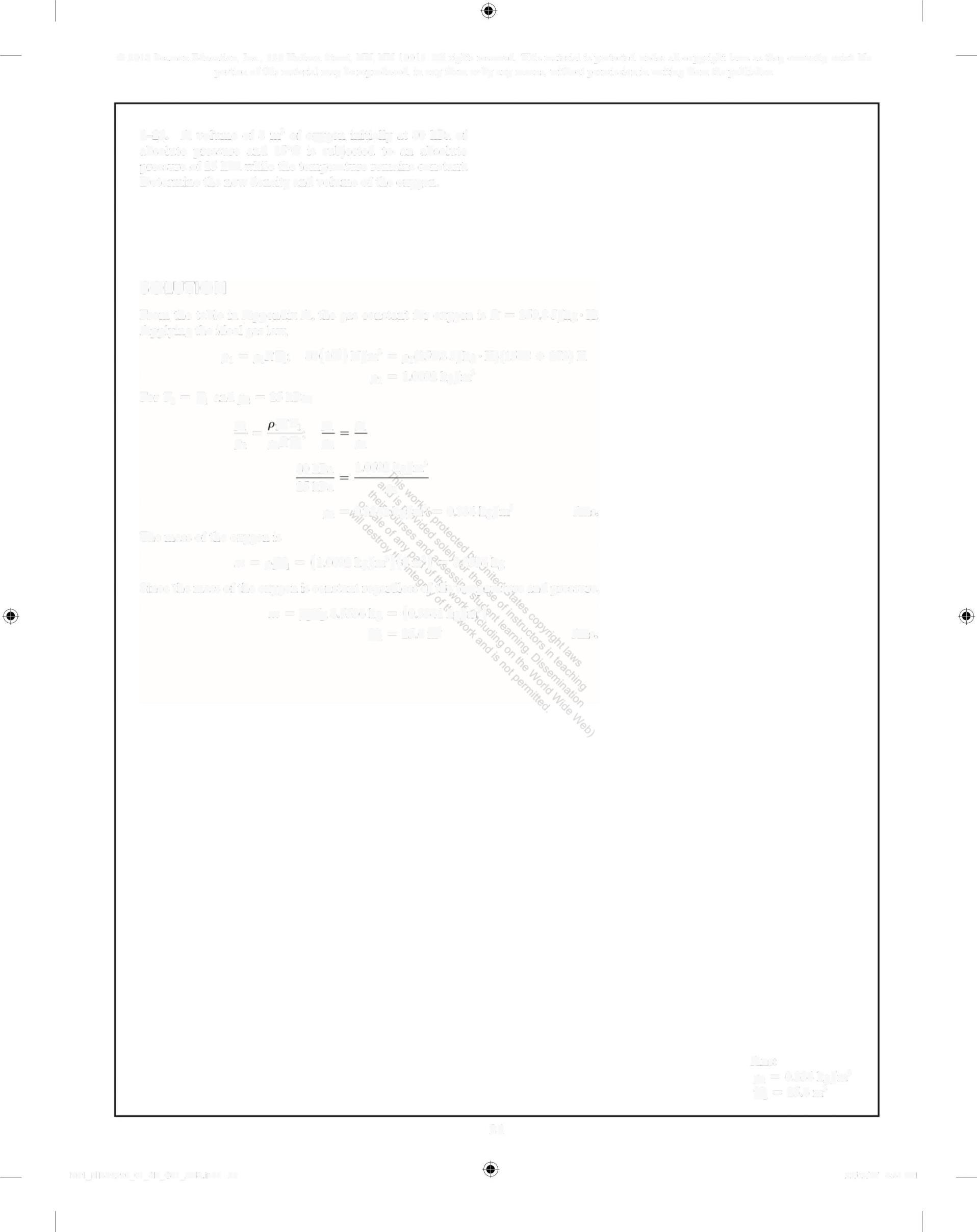
Pt = 1 0692 kg/m'
For T, = T, and p = 25 kPa
P RT p P -=-P> 0RT,' P P 80 kPa 25 kPa 1.0692 kg/m' P2
p= 0 3341 kg/m' = 0 334 kg/m'
Ans.
The mass of the oxygen is
m = = (1 0692 kg/m')(8m') = 8 5536 kg
Since the mass of the oxygen is constant regardless of the temperature and pressure,
m = o;8 5536kg = (0 3341 kg/m') ,=25 6m Ans.
Ans: p=0 334kg/m' ,=25 6m'
1-22 When a pressure of 650 psi is applied to a solid, its specific weight increases from 310 Ib/ft' to 312 lb/ft3 • Determine the approximate bulk modulus SOLUTION
Differentiatin
= W with respect toy, we obtain
Therefore,
The more precise answer can be obtained from
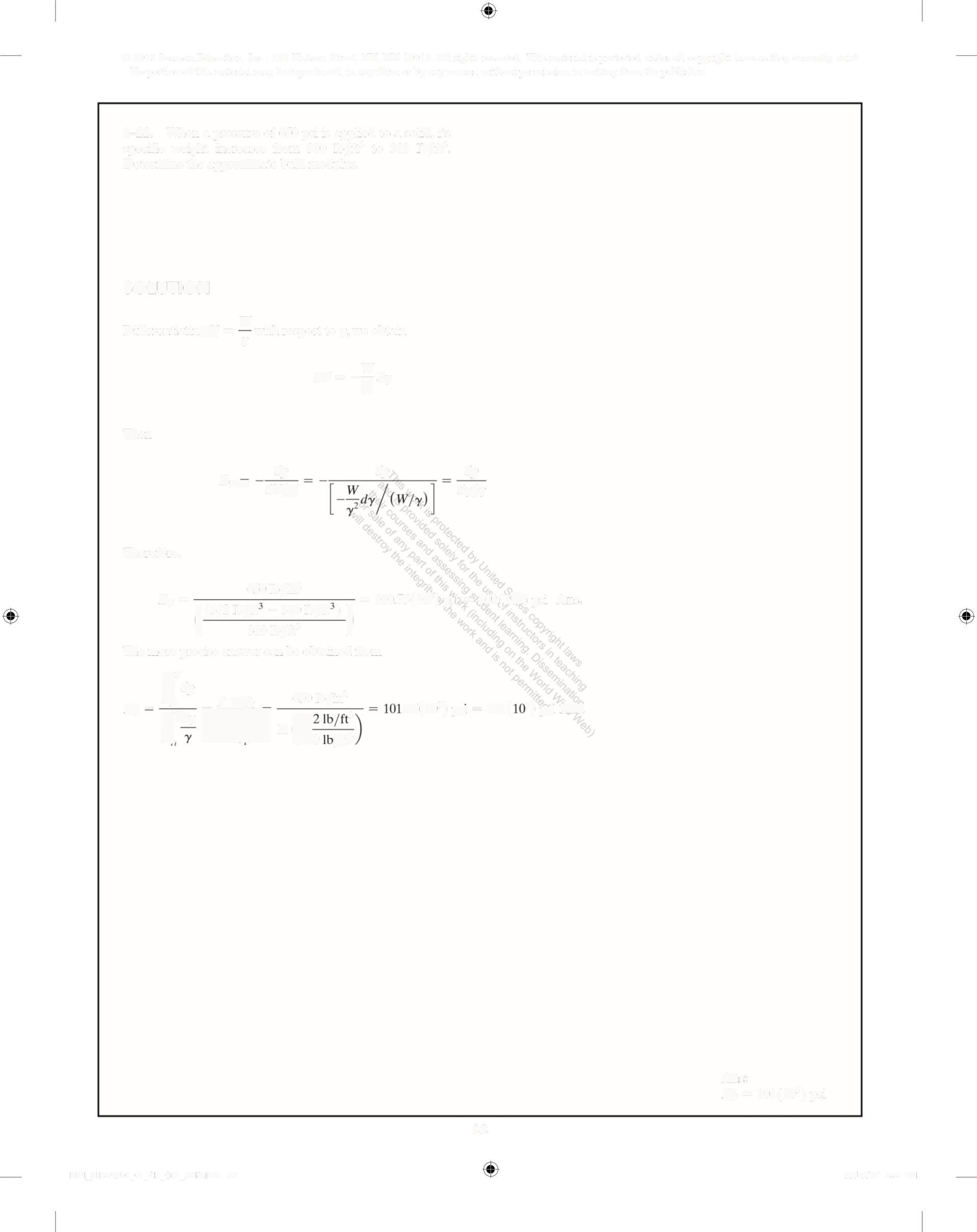
1-23. Water at 20°C is subjected to a pressure increase of 44 MPa Determine the percent increase in its density Take E = 2 20GPa SOLUTION
Ap m/, m/, 9 m/,
To find/,, use Ev = -d,/(/V) d dp V E
So, since the bulk modulus of water at 20Cis E = 2 20 GPa,
A4p = op/E 1 p = a(4MPa)/220GPa) 1 =00202= 2 02% Ans
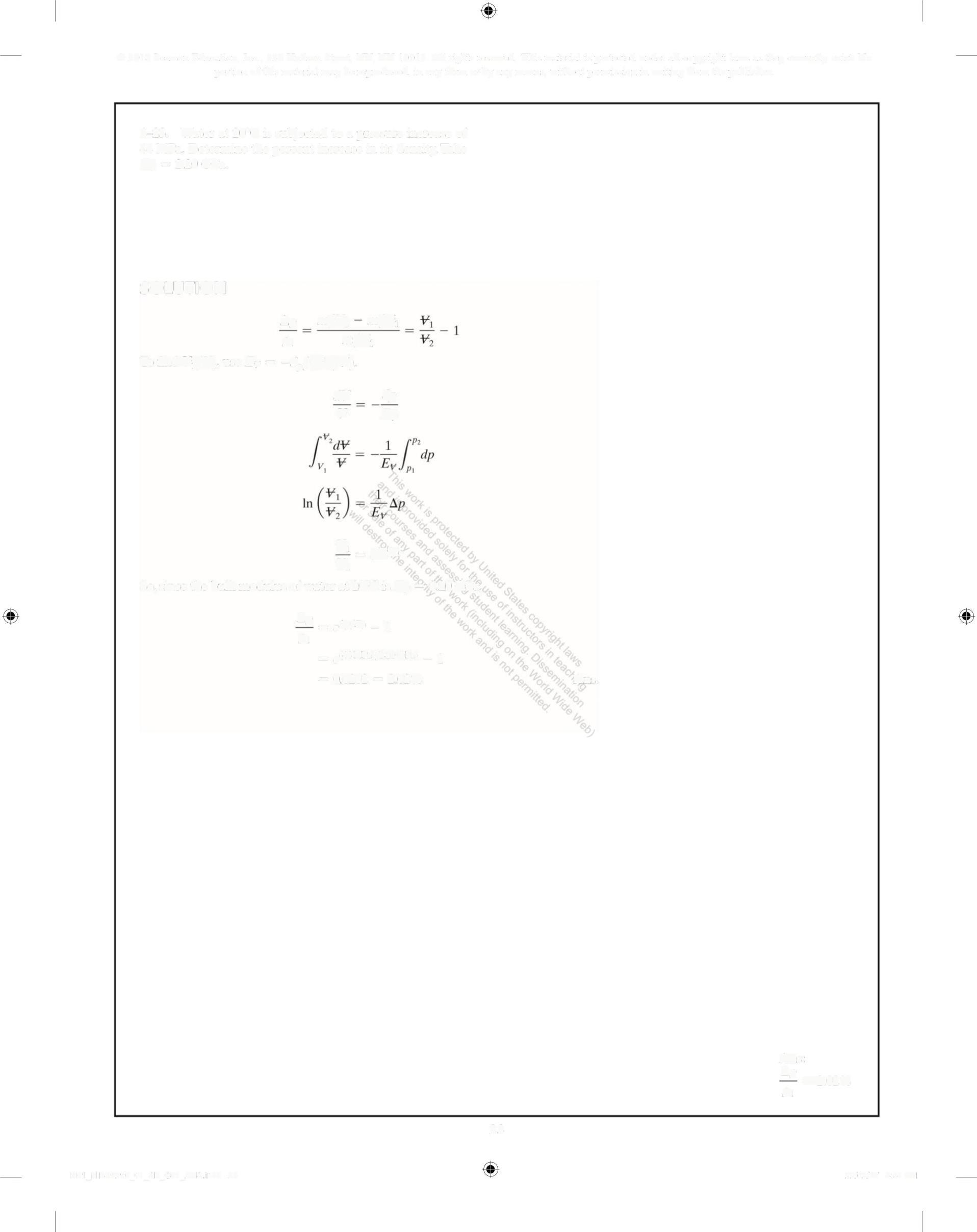
*1-24 If the bulk modulus for water at 70 °F is 319kip determine the change in pressure required to reduce its volume by 0 3%
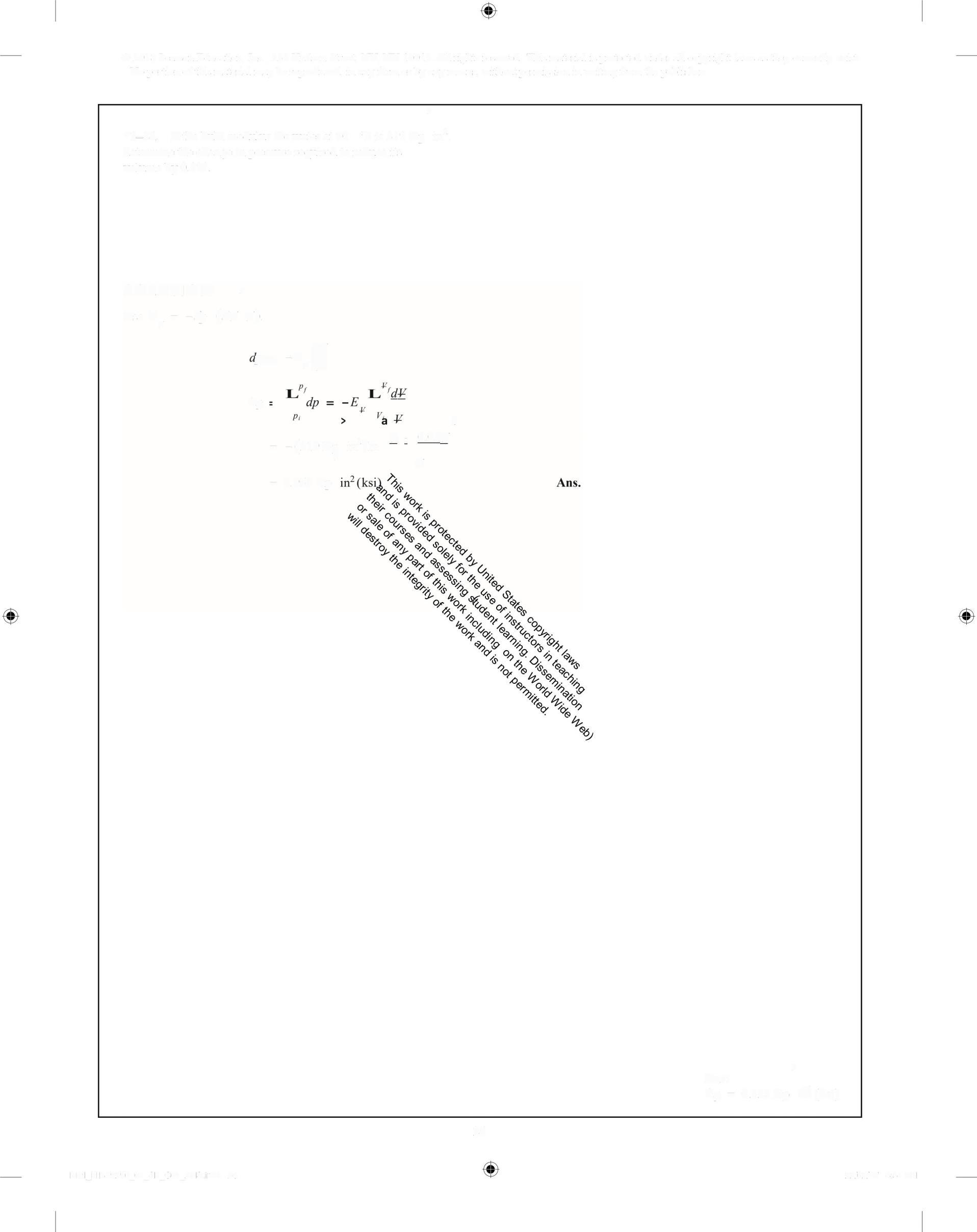
1-25. At a point deep in the ocean, the specific weight of seawater is 64 2 lb/ft3 Determine the absolute pressure in lb/in2 at this point if at the surface the specific weight is
y= 63 6lb/ft'and the absolute pressure is p,, = 14 7lb/in
Take E = 487(10°) 1b/ft
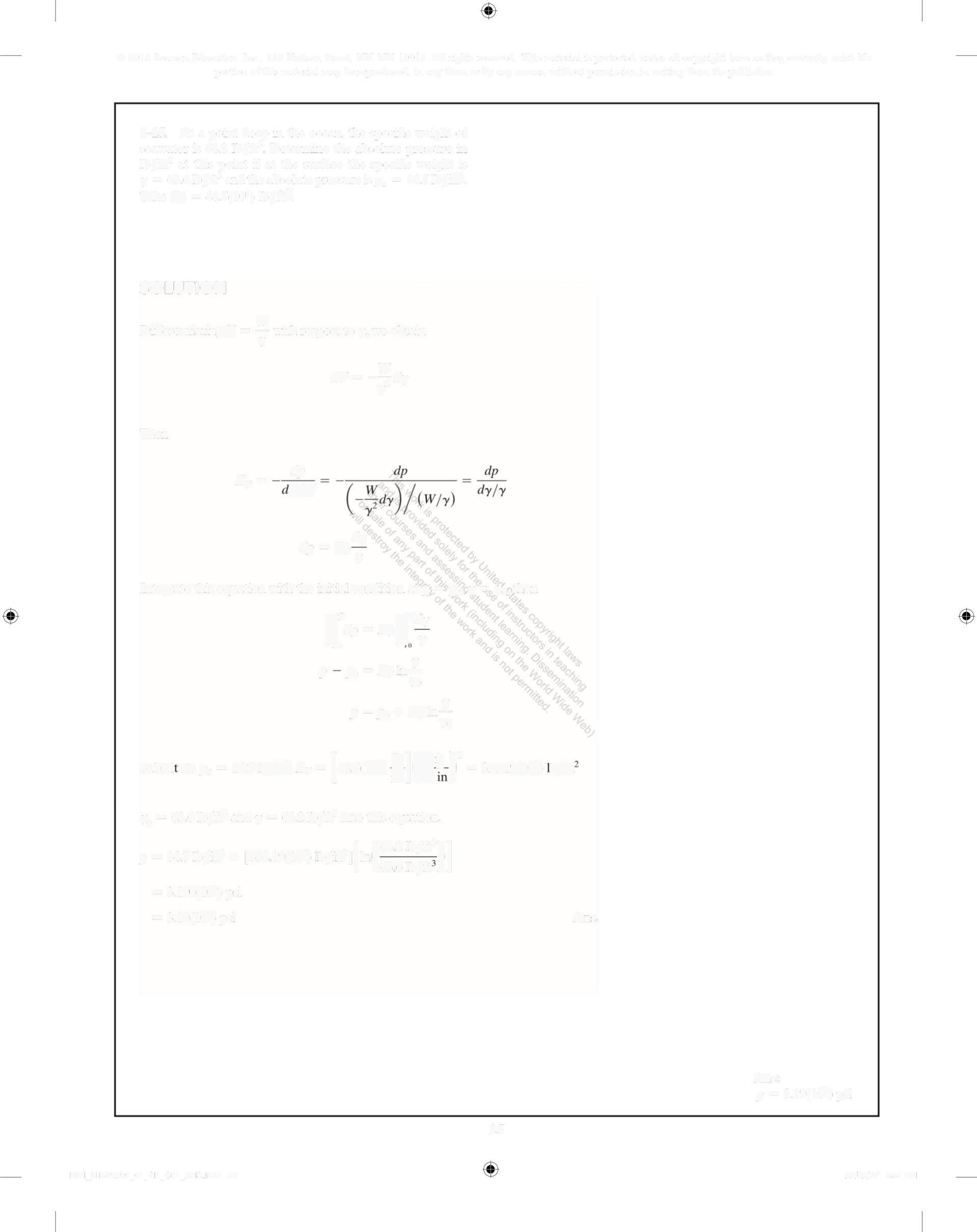
SOLUTION
w Differentiating = - with respect to y, we obtain Y w d=-dy 'Y2
Then dp Ee = y
dy dp = E Y
Integrate this equation with the initial condition at p = Pay = 'Yo, then
pdp =E l"'ldy
P Y
p p= El Y n %
p =p+ Eln Y Y0
so+aen - +7/ E,
y,=63.6lb/ft and y = 64.2 lb/ft' into this equation,
3 64 2 lb/ft )]
p= 14 7lb/in [338 19(10) 1b/in]] [ n](63 6 lb/ft
= 3 190(10) psi
= 3 19(10) psi Ans.
Ans:
p=3 19(10) psi
1-26 A 2-kg mass ofoxygen is held at a constant temperature of50 °C and an absolute pressure of220 kPa Determine its bulk modulus
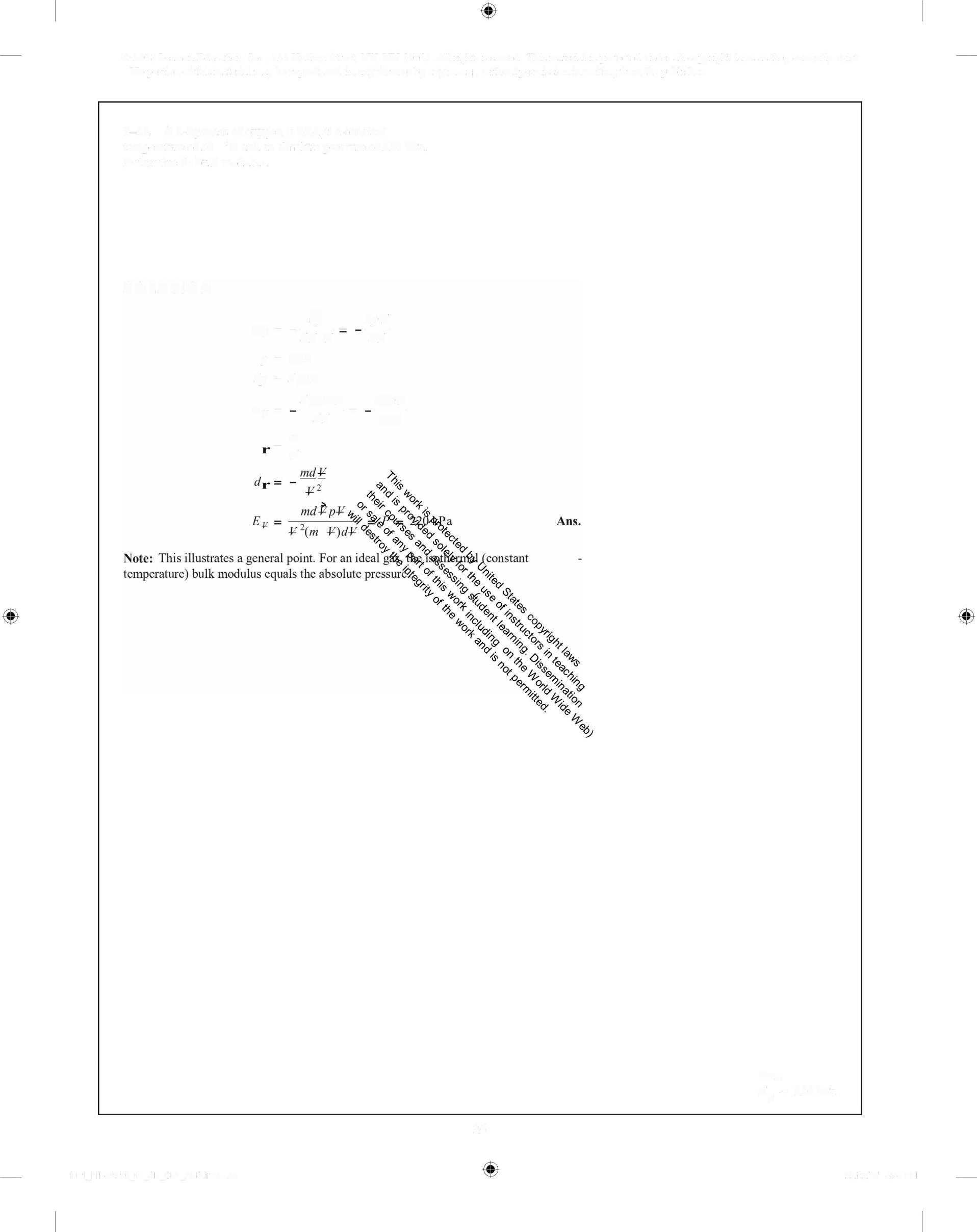
•
dV ¥ d•
= RT
= d,RT
= 220 kPa
1-27. The viscosity of SAE 10 W30 oil is p= 0 100 N s/m
Determine its kinematic viscosity The specific gravity is S,, = 0 92 Express the answer in SI and FPS units
SOLUTION
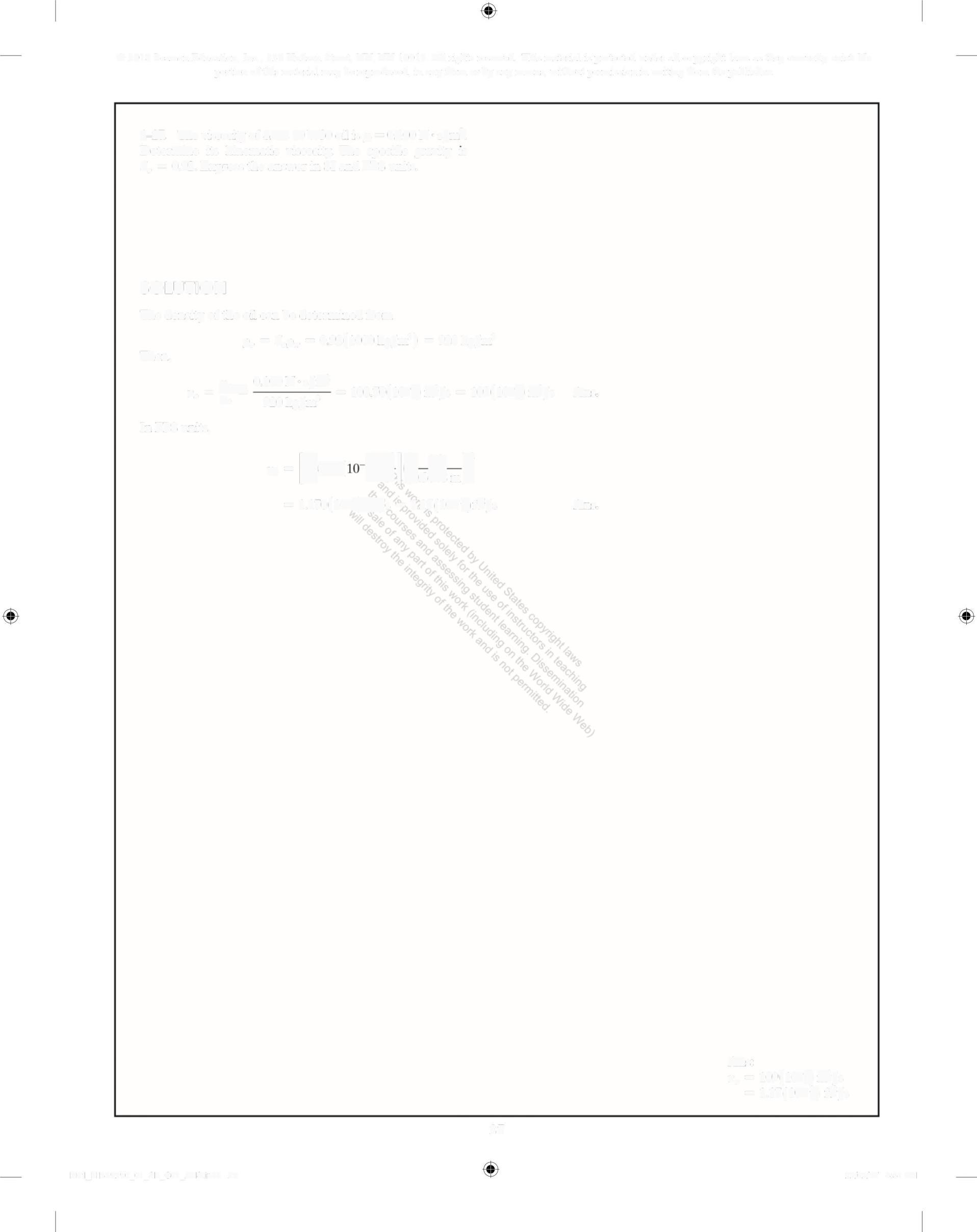
The density of the oil can be determined from Then, P,=S%0, = 0 92(1000kg/m') = 920 kg/m' , 0 100N s/m , 0 =E" =108 70(10)nm/s = 109(10)m/s Po 920 kg/m'
In FPS units,
= 1 170(10)/s = 117(10)ft/s Ans
v,, = 109(10)n/s
= 1 17(10) ft/s
> *1-28. If the kinematic viscosity of glycerin is n = 1 15(10') m s, determine its viscosity in FPS units At the temperature considered, glycerin has a specific gravity of S = 1.26 g
The density ofglycerin is >
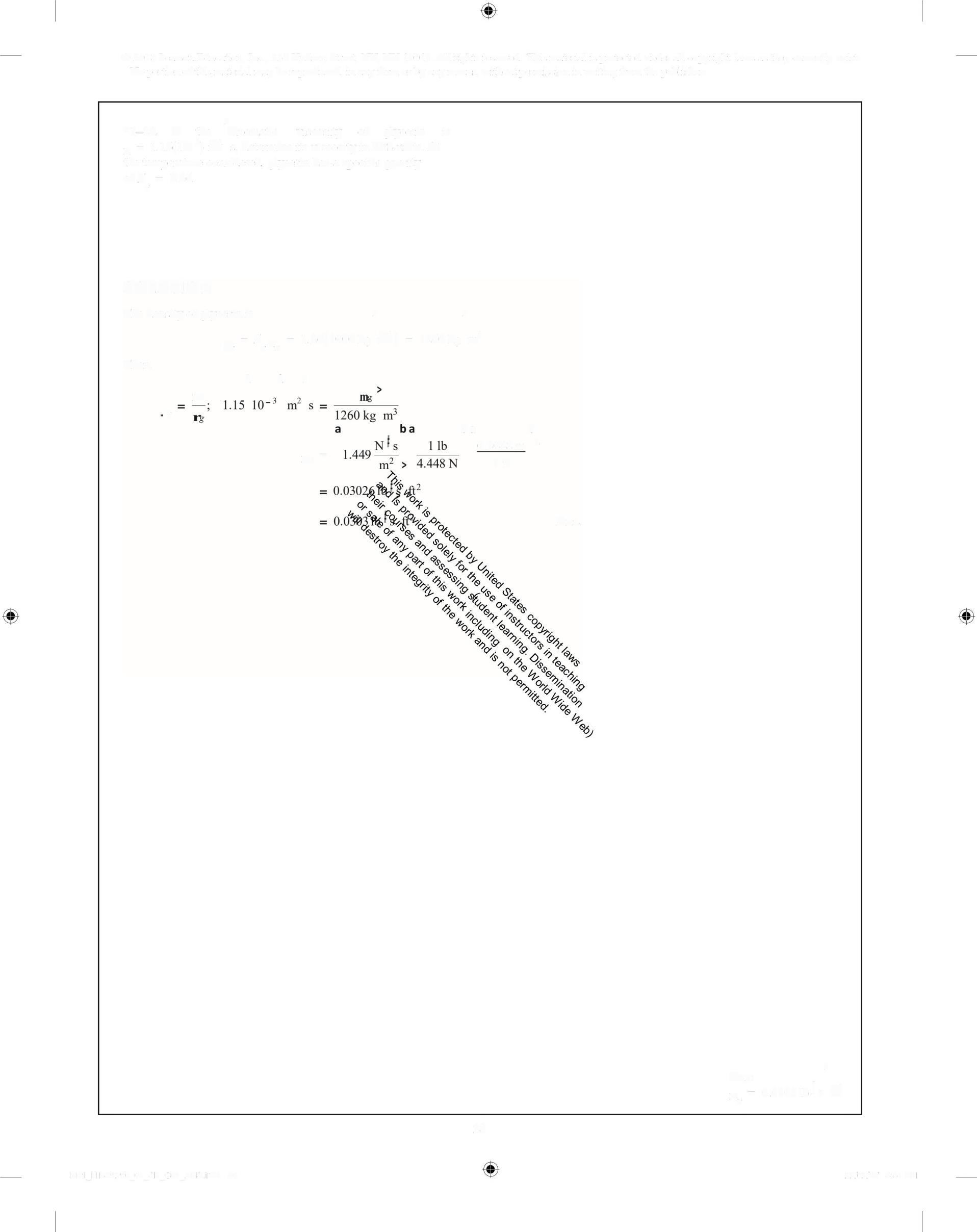
1-29. An experimental test using human blood at T = 30°C indicates that it exerts a shear stress of r = 0 15 N/m on surface A, where the measured velocity gradient is 168 s' Since blood is a non-Newtonian fluid, determine its apparent viscosity at A
SOLUTION
Here, du - 168 s -1 and r 0 15 N/ .2 m Thus,
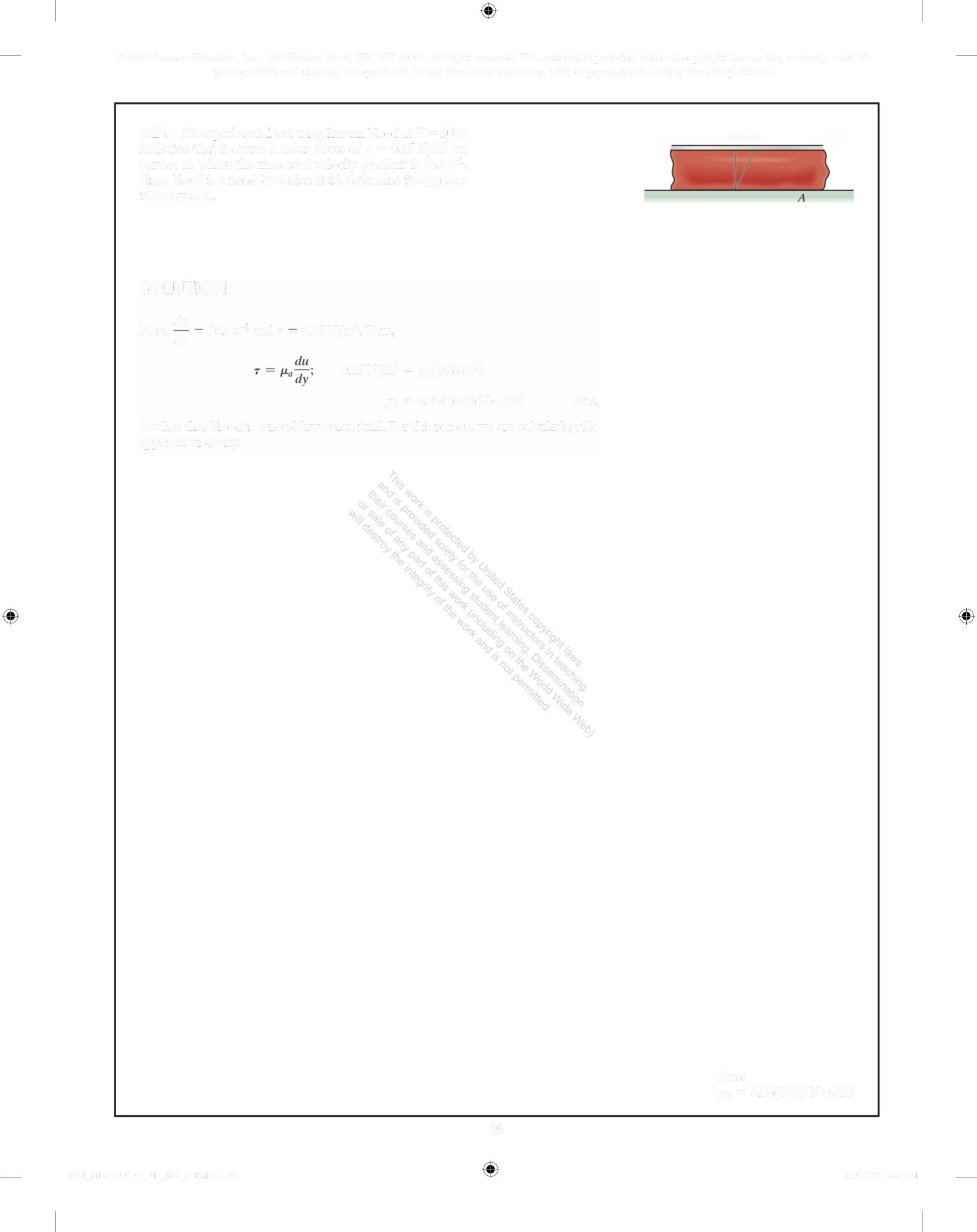
015 N/m = ,(16 8s') ,, =8 93(10)N s/m Ans. Realize that blood is a non-Newtonian fluid. For this reason, we are calculating the apparent viscosity
Ans: ,, = 8 93(10)N s/m
1-30. The plate is moving at 0 6 mm/s when the force applied to the plate is 4 mN lf the surface area of the plate in contact with the liquid is 0.5 m, determine the approximate viscosity of the liquid, assuming that the velocity distribution is linear
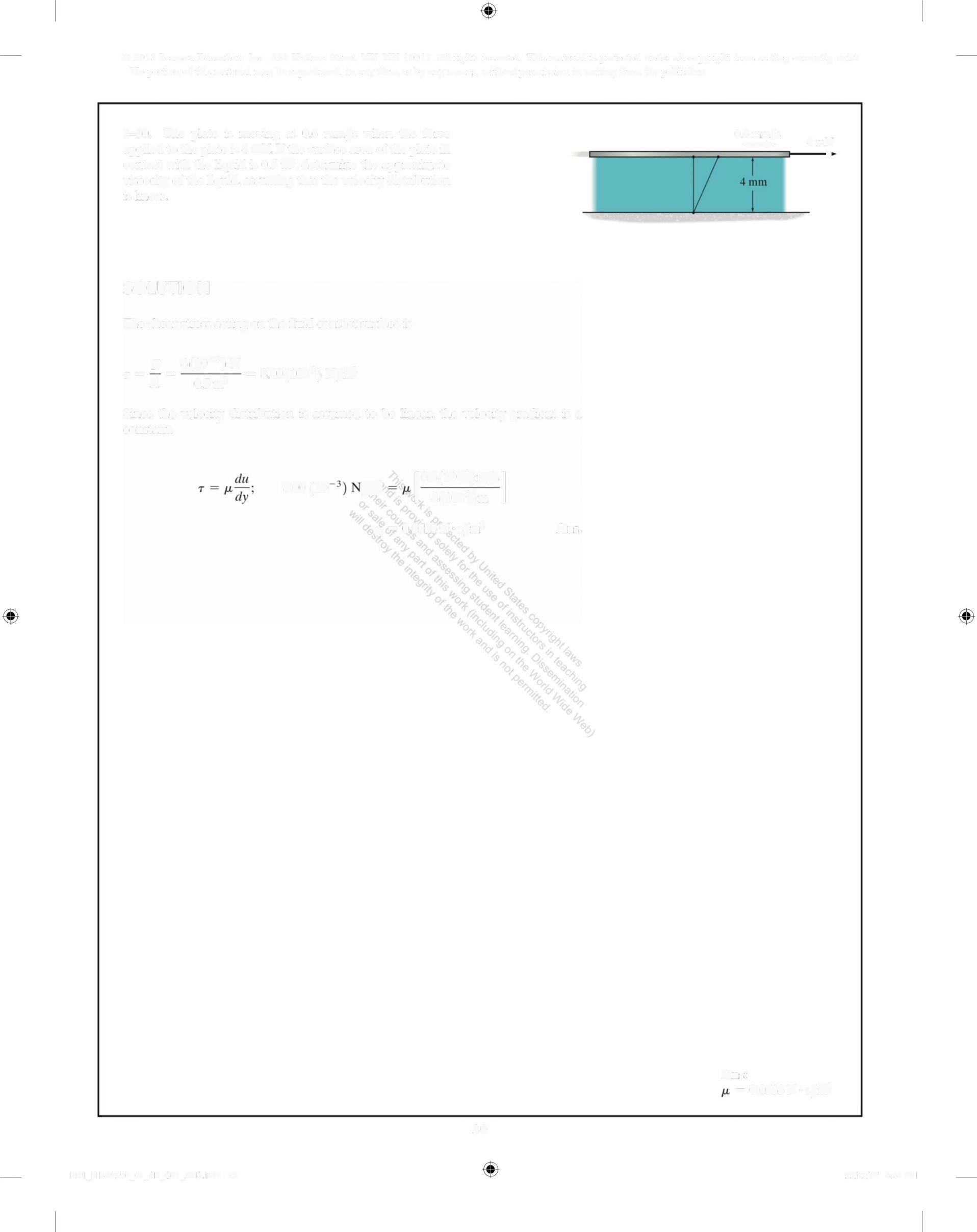
SOLUTION
The shear stress acting on the fluid contact surface is
Since the velocity distribution is assumed to be linear, the velocity gradient is a constant.
